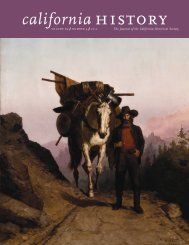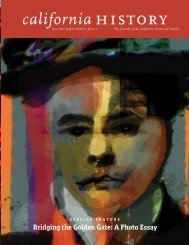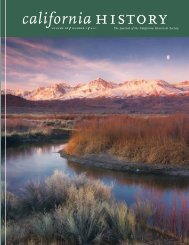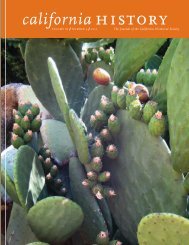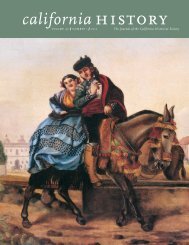In 1991, the university once again attempted toregain control of People’s Park by evicting thehomeless and others in order to construct volleyballcourts. On July 31, following fruitless town-gownnegotiations, campus administrators sent in bulldozers,sparking riots and protests. Although thecourts were removed in 1997, over the years theuniversity’s plans to erect structures in the southcampus area have created an enduring challengeto those who wish to maintain the park’s statusas a community mainstay and historical-politicallandmark.Courtesy of Terri CompostPark riots as a clash between “two opposed andperhaps irreconcilable ideological visions of thenature and purpose of public space, two opposedvisions that have a great deal of impact on howthe right to the city is conceptualized and forwhom it is a viable right.” 62On one side, adhering to “the same sorts of ideologicalvisions for public space” as the originalfounders of People’s Park, a coalition of politicalactivists and homeless users of the park “provideda vision of space marked by free interactions,user determination, and the absence ofcoercion by powerful institutions.” In this view,the park was “recognized as a refuge for homelesspeople since its founding.” The alternateposition, advocated by the university, envisioneda vastly different People’s Park that would be“open for recreation and entertainment” and“subject to usage by an appropriate public (students,middle class residents, and visitors, etc.)that used the space by permission of its owners.”Under the university’s “planned, orderly, andsafe” conception of People’s Park, appropriateusers needed “to feel comfortable” and therefore“should not be driven away by unsightly homelesspeople or unsolicited political activity.” 63In 1992, People’s Park faced another crisis whoseresolution, despite its preservation as open space,provided no certainty that it could survive withits original ideals intact. In the early morninghours of August 25, Rosebud Denovo, a youngrunaway from Kentucky with a <strong>history</strong> of psychologicalproblems, broke into the home ofChancellor Chang-Lin Tien and was killed by anOakland policeman. The twenty-year-old victimoften had slept in People’s Park and had beenamong those who had rioted against constructionof the volleyball courts. The official version of herdeath stressed two points: that the self-professedanarchist had intended to kill the chancellor andhis wife with a machete and that the officer whofired the fatal shots had acted in self-defense afterDenovo swung the weapon at him. Any actualknowledge of Denovo’s intentions died with her;many of her friends believed that she only hadplanned to destroy paintings and furniture withthe machete. Despite the officer’s claims that hefell backward into a bathtub and shot upward at <strong>California</strong> History • volume 88 number 1 2010
Denovo, her autopsy revealed a downward trajectory,indicating that the police officer had firedfrom an upright position. Police Review CommissionerOsha Neumann and other critics questionedwhy, following Chancellor Tien and hiswife’s safe evacuation, there had been no negotiationsto persuade Denovo to surrender withoutincident. At the time of her death, Denovo carrieda handwritten note in her duffel bag vowing,“We’re ready to die for this land. Are you?” 64Ultimately, the university spent a million dollarsto build sand volleyball courts, though few communitymembers used them. In January 1997,the university removed the volleyball courts butmaintained a basketball court that also had beenbuilt in the early 1990s and was also a source ofcontroversy. Today, People’s Park remains a freepublic park from 6 a.m. to 10 p.m. serving primarilyas a daytime sanctuary for the homeless.The People’s Stage still hosts occasional ralliesand concerts on the park’s western end. 65On April 26, 2009, the stage became the focalpoint of the People’s Park fortieth anniversarycelebration. Two days earlier, Delacour,Schlesinger, Bardacke, and Van der Ryn hadspoken at a founders forum. Five years earlier,on the eve of the park’s thirty-fifth anniversary,Schlesinger had revealed a new account ofthe park’s founding: the original impetus hadbeen Delacour’s desire for a site to host theirromantic rendezvous. Delacour, who previouslyhad insisted that his motive was a desire for “afree speech area that wasn’t really controlledlike Sproul Plaza,” did not deny his romanticinvolvement with Schlesinger. However, herefuted Schlesinger’s explanation, adding simplythat other, more overtly political issues wereinvolved. 66Judy Gumbo Albert, Stew Albert’s widow and afellow activist, also attended the anniversary celebration.She described Delacour as “one of theunofficial keepers of the park’s flame.” Supportersof People’s Park, nevertheless, must wonderabout its future after Delacour and the originalfounders are gone. Already, the university warnsincoming freshmen of the park’s dangers, indoctrinatinga younger and more conservative generationwith a negative view of People’s Park. Yet,in an April 2000 referendum, students voted infavor of maintaining the park as it is, rather thanturning to an alternative use of the land, such asadditional housing. 67Is the university now just waiting for a futuretakeover, biding time until it can convincestudents of the park’s evils? Or will studentscontinue to resist the university’s efforts andsupport the park? Devin Wooldrige, communityrelations site coordinator of People’s Park for thelast nine years, believes that such distrust of theuniversity is simply misplaced: “The Universitypumps quite a bit of money into the park and Idon’t believe the park is now, or will be, in dangerof being redeveloped.” If Wooldrige is correct,People’s Park will always stand as a symbol ofgrassroots democracy. 68In her article on the park’s fortieth anniversarycelebration, Judy Gumbo Albert compared thepark then and now: “Maybe 50% hippies andfreaks, and the other 50% just plain folks: men,women, children, neatly dressed students, Vietnamvets, homeless women and men, bellydancers, bongo drummers, black, white andmulti-ethnic, one crowd, together, happy underthe warm <strong>California</strong> sun. Sitting on remarkablywell-tended and clipped grass, with the unmistakablesweet odor of that other grass thick in theair. Just like I remember.” 69Jon David Cash is the author of Before They Were Cardinals:Major League Baseball in Nineteenth-Century St. Louis (Universityof Missouri Press, 2002), a 2003 finalist for the SeymourMedal, awarded annually by the <strong>Society</strong> for AmericanBaseball Research (SABR) to the best book of baseball <strong>history</strong>or biography. He holds a PhD in American <strong>history</strong> from theUniversity of Oregon and currently lives in his hometown ofCrossett, Arkansas.9
- Page 3: california historyvolume 88 number
- Page 6 and 7: c o l l e c t i o n sAdmission tick
- Page 8 and 9: c o l l e c t i o n sBusiness cards
- Page 10 and 11: People’s Park:Birth and SurvivalB
- Page 12 and 13: even on existing dorms due to the h
- Page 14 and 15: The attraction, however, was fleeti
- Page 16 and 17: Bay Area—North Beach and Haight-A
- Page 18 and 19: A hundred students, activists, and
- Page 20 and 21: are building a park on the land. We
- Page 22 and 23: and illegal drug use in the park. T
- Page 24: without even allowing Siegel to con
- Page 27 and 28: As Bloody Thursday came to a close,
- Page 29: this state.” On June 20, Reagan t
- Page 33 and 34: ation and encouragement, and shed n
- Page 35 and 36: the guardians of her children. The
- Page 37 and 38: mitted to visit Caroline in her new
- Page 39 and 40: Sojourner Truth gave what famously
- Page 41 and 42: After emancipation, she helped to o
- Page 43 and 44: This 1885 view captures the sparsel
- Page 45 and 46: But Caroline thought it imprudent t
- Page 47 and 48: The “Mother of Clubs”In Boston,
- Page 49 and 50: Caroline attended the September 189
- Page 51 and 52: ments, Seymour and Sibley earned pe
- Page 53 and 54: In this photograph, San Francisco s
- Page 55 and 56: n o t e s12People’s Park: Birth a
- Page 57 and 58: 1969; McGill, The Year of the Monke
- Page 59 and 60: that “thousands of the brightest
- Page 61 and 62: For Both Cross andFlag: Catholic Ac
- Page 63 and 64: d o n o r sThe California Historica
- Page 65 and 66: In Kind DonationsSandy Alderson, Sa
- Page 67: Membership BenefitsJoin tHeCaliforn



